-

人教版高中英语必修2The Olympic Games说课稿2篇
Purpose of my design:To ask the students to do these two tasks will make the Ss predict the story of this passage. As a result, it will deepen Ss’ memory of this story because they will have their own understanding of this story.Step 3. While-readingTask 1. (Individual work _____min)Skimming: ask students to skim the text and the main ideas of each paragraph in this passage. Please read it quickly and then match the sentences with the letters.Task 2. (Individual work _____min)Scanning: read the text quickly and decide the whether the following statements are true or false and give reasons.Task 3. (Pair work _____min)Listen to the tape and fill in the banks. Then read the paragraph with expression to your partner.Task4 (individual work min)Listen to the tape again and write down the main idea in one sentence.Purpose of my design: Enable students to understand the given material better by using different reading skills. And proper competition can arouse the Ss’ interest in English learning. “Task-based” teaching method is used here todevelop the Ss’ ability of communication and also their ability of co-operation will be well trainedStep 4. Post-readingTask 1. (Individual work, pair work, group work, class work; _____min)Discussion (group of 4):1. If you were Hippomenes, would you run against Atlanta?2. Do you think Hippomenes deserved to win the race? Why or why not?Step 5. HomeworkPlease read the story again carefully after class and imagine: What will happen during the race between Hippomenes and Atlanta? Who do you think will win the race? Do you think Atlanta would marry Hippomenes? Write an end for the story with thses questions.Purpose of my design: Homework is so important and necessary for to master the knowledge they learned after class. It will check whether the Ss achieve the teaching aims.Part 5 Blackboard design

人教版高中英语必修2Wildlife Protection说课稿3篇
When it comes to the students’ studying methods, I'd like to introduce my Ss first. The Ss have a good command of basic language points. They’re interested in learning English, and they take an active part in English class, so they will have fun in autonomous, cooperative and inquiry learning. I will just serve as a guide, showing them the way to explore how to make more progress in their English learning.Now it’s time for the most important stage of this lesson. My teaching procedures are arranged as follows:Step1.Leading-in (3 minute)Play a video of a wide variety of wildlife to introduce my topic. Step2. Speaking (12 minutes)We will use our textbook Page25. Let the Ss fast read the short paragraph to warm up. Ask them to talk about the report on some endangered wildlife in China with the dialogue patterns on the screen. Lastly, I will invite some groups to demonstrate their dialogues about saving wildlife in China.Step3.English play (3 minutes)Watch another video in praise of their excellent performance just now. It’s about Jack Chen’s(成龙)and Yang Ziqiong’s wildlife protection.Step4. Listening (twice 13 minutes)This time, I’ll ask the Ss to fill in the blanks of the monologue of the 2 movie stars above. Step5.Discussion (3 minutes)Which would you like to choose to wear, clothes made of cotton, artificial leather or animal skins? Why ?Step6. Summary (3 minutes)1. If there were no wildlife, there wouldn’t exist human beings. If the buying stops, the killing can, too.2. Animals are our friends. To love animals is to love ourselves. Stop hunting, killing and destroying wildlife.3. Let’s live in harmony with all the living things in the world. Step7. Music appreciation (3 minutes)Let the Ss appreciate the song Earth Song by Michael Jackson. Last but not the least, I will show you my blackboard design.

人教版高中英语必修4A taste of English Humor说课稿3篇
Then I would ask them to think of a funny English or Chinese and tell it to partners. While telling stories, they can use expressions and some acting to help make the story funny. 5 minutes would be given to do this.Those stories they told there will be the material for their writing. Soletting them tell it at first is helpful. And they can make a difference between telling a funny story and writing it down. Generally speaking, it is difficult forstudents to write well because they don’t know what to write and how to write. Asking them to tell their own stories at first can help them come up with what to write.After their telling, I would invite someone to share his/her story with all of us and I would write it down on the blackboard.This example story would be used as a sample to illustrate the format of funny story. Different from a story from teacher or textbook, a story from students can obviously become a interesting material to draw students’ attention.Then I would ask the whole class to put this story into several parts. It might be a little bit difficult for them. So I would ask them to find out whether all the sentences are necessary. After delete some sentences, there are 6 sentences left behind. Then they can easily put them into three parts. After interaction with students, I would teach them the right terms for each part and conclude the format of funny story.This step is the key and difficult point in my lesson. So I mainly usetask-based teaching method in this part and the task for students was divided into several stages. With the separated difficult level, students can find there are usually three parts in writing. They can also learn to write without the unnecessary parts in the process of analyzing. And then I wouldn’t rush to tell them the right terms to them directly. Instead, I would ask them to name them by their own. A confused mind is better for acquiring knowledge.While-writing:Then I would give students 7 minutes to write down this story, without other requirements.With all the preparations in pre-writing, students’ difficulties were cleared. So it would be much easier for them to write down the story within 7 minutes. There are no other requirements because students’ first writing is actually a drafting. It would be revise and edit several times later. Writing, as a skill

人教版高中英语必修4Women of achievement说课稿4篇
Good morning, distinguished judges:It’s my honor to talk about my teaching ideas with you. Today my topic is Women of Achievement. My presentation consists of six parts: the analysis of teaching material and student, teaching aims, key and difficult points, teaching and studying method, teaching procedures and blackboard design.First, let’s focus on the analysis of teaching material. This lesson is from New Senior English for China Student’s Book 4 Unit 1, the reading part. The main topic of the passage is the introduction of a student of Africanwildlife. After this lesson, the students will learn more information about her studying chimps in Africa, and their reading and speaking abilities can be developed as well.The next part is the analysis of students. My students are in senior high students. They have learnt English for many years, they’ve known many words and sentences, but their speaking and reading abilities are still not very good. So I will practice their speaking and reading abilities through different exercises.According to the New Standard Curriculum and the present situation, I set the teaching aims as follows: firstly, knowledge aims. Students can grasp some new words, such as worthwhile, move off. Moreover, students can understand the content of the passage and get familiar with the topic of studying chimps in wildlife. Secondly, ability aims. Students can use reading strategies such as skimming and scanning in reading process. Thirdly, emotional aims. Students can have the awareness of protecting animals and care about animals.Based on the above analysis, the key point of this lesson is to get the main idea and the detailed information from the passage; the difficult point is to talk about the wildlife protection and use reading strategies.

人教版高中英语必修3Festivals around the World说课稿3篇
Teaching plan for Unit 1 book3Good morning, teachers. It’s my great pleasure to be here because I can share my lesson with you and I can learn a lot from it. I’ll begin my lesson from the following four parts, the teaching material, the teaching methods, the studying methods and the teaching procedure.Firstly, let me talk about the teaching material. The content of my lesson is the reading passage festivals and celebrations of Unit 1 Festivals around the world. This passage is about festivals and celebrations. By studying this passage, we’ll enable the students to know that festivals exit everywhere, and many of festivals in different countries celebrate similar ideas. As we all know, the reading passage is the center of each unit. If the Ss can learn it well, it will be helpful to make the Ss learn the rest of this unit.After studying the teaching material, I think the teaching aims are as the followings:1. Knowledge aims:(1) The Ss can master the usage of the important words andexpressions.(2)The Ss can use the __________________ (grammar) in the proper situation.Make students know about the festivals all over the world and the detail of the festivals, such as origin, content, and the date of the holiday festivals.2. Ability aims:(1) Students can talk about festivals and celebrations in English(2) To improve the student’s reading ability, especially their skimming and scanning ability.3. Emotion aims:Make the Ss know about the foreign festivals, and respect other countries’ custom.Next, let’s come to the important points and the difficult points.The important point is how to make the Ss understand the text better and the difficult point is how can they talk about it. secondly, Teaching Methods:1. task-based Language Teaching2. Computer assisted language teaching.3. question-and–answer methodThirdly, Studying Methods:

人教版高中英语必修3Healthy Eating说课稿4篇
Language learning needs a context, which can help the learners to understand the language and then can product comprehensible output, so computer has the advantages to make the materials attractive.Part 3 Learning MethodsTask-based, self-dependent and cooperative learningPart 4 Teaching ProcedureStep One Lead-in“Interest is the best teacher.” Therefore, at the very beginning of the class, I should spark the students’ mind to focus on the centre topic “the band”. I’ll show some pictures of food to attract their attention and then bring some questions.Question:What kind of food they like?What should go into a good meal?The answers must relate to the diet. After this, the students will be eager to know something about a balance diet and this is the very time to naturally lead the class into Step 2Step 2 Reading for information: skimming and scanning In this step, I use Task-based Language Teaching method, which can give students a clear and specific purpose while skimming and scanning the context.Task 1 General ideaThe students will be asked to just glance at the title and the pictures of the passage, and then guess what they will read in the text. And they’ll be divided into groups of four to have a discussion.The purpose is to inspire the students to read actively, not passively. In addition, the task is to develop the students’ reading skill by making prediction and to encourage the students to express their thoughts in English and cooperate with each other.Task 2 Main idea of each paragraphCooperative learning can raise the students’ interest and create an atmosphere of achievement. Based on this theory, I divide the whole class into 4 groups to skim the whole text and get the main idea of each paragraph.

人教版高中英语必修4Working The Land说课稿3篇
Knowledge objectives:(1) to make Ss grasp the usage of words, expressions and sentence structures: statistics, struggle, thanks to, rid of, some patterns for persuasion, the “ing” form as subject and object;(2)to use learnt knowledge to persuade sb.Ability objectives:(1) to develop Ss’ reading skills(skimming, scanning, word guessing);(2) to improve Ss’ speaking, communicating and cooperating skills.Emotional objectives:to make Ss know the contribution of Yuan,and learn his spirit and his simple life time.Teaching important and difficult points:(1) some words, expressions and sentence structures mentioned above;(2)the content of the text;(3)training their reading and speaking skills.Teaching methods: CLT, TBLT,QT.Learning strategies: CLS, QLS, TBLS.Teaching procedures:Step 1 lead-in: (1) teacher plays a piece of recent news from CCTV about the harvest of the super hybrid rice, and ask students whether they know Yuan or not, and talk about him and his contribution.(2)Brain storm: let Ss describe Yuan in their minds including his appearance, his living condition and so on.Step 2 fast reading tasks:(1)teacher introduces Yuan and super hybrid rice(2)make Ss read the text as fast as possible with questions. Such as: what’s the general ideaof this passage? What’s Yuan’ dream? (skimming and scanning skill)Step 3 intensive reading tasks(1)let Ss read the text silently, find topic sentence of each paragraph and draw the difficult sentences and the knowledge what they don’t understand.(words guessing)(2)teacher and Ss talk about the important words, expressions and sentences together, and ask Ss to retell the content of the text.(summarizing and paraphrasing)(3)teacher summarize this part.(4) read again following the courseware.

人教版高中英语必修5First aid说课稿6篇
In this class, I have 3 teaching aims, that is, knowledge aims, ability aims and emotion aims.1) Knowledge-Teach students new words and expressions, such as temporary, bleed,sprain choke, first aid, fall ill and so on.-Enable students to have a better understanding for some basic knowledge of first aid.2) Ability-Train students’ speaking, reading and writing abilities by different teaching activities, such as skimming, comprehending, team work, role play, retelling and writing.-Develop students’ reading strategy on how to move general idea to specific information.3) Emotion-Promote students’ awareness of giving first aid.- Cultivate students’ creativities.Then let’s come to my teaching methods and activities.III. Teaching methods and activities:To achieve different teaching aims, various kinds of teaching methods and activities will be adopted throughout this period, such as TBL (task-based learning), skimming, team work, brainstorm and others, which can offer students opportunities to fulfill tasks in which they can use language to achieve a specific outcome.IV. Teaching aids:Computer and blackboardV. Teaching important points:1) Make students have a clear mind for the structure of the text.2) Help students understand the theme of the text.VI. Teaching difficulties:1) So many new words may affect students’ understanding.2) How to get students to know about the functions of the skin and thecauses, characteristics and treatments for different degree burns,and the knowledge about giving first aid. VII. Blackboard design:

人教版高中英语必修5Great scientists说课稿4篇
通过写文章梗概,培养学生综合运用语言的能力,学习用恰当的英语描述科学家的故事。这是本课的教学难点。教师可以使用完形填空的方式来帮助学生整理语篇,从而来降低难度。本课的教学重点的突破方法是:在阅读前,让学生初步了解得出科学观点所需要的基本程序,从而轻松而自然地导入文章的阅读;在阅读过程中,由易到难设计快速阅读和精读的问题,层层推进各种阅读活动,让学生对阅读内容从整体感知到细节理解,最后深层读懂整篇文章,同时加强阅读策略的指导,让每个学生都主动参与课堂教学活动,最终达到提高阅读能力的目的。Step 4 Post-readingGroup Activities四人小组共同合作,在老师的适当指导下,就以下2个问题展开讨论,让学生就所知、所学、所感和所想融入话题,然后抽若干同学代表作小组发言。1. What do you think about John Snow, and what should we learn from him?2. Cholera was 19th century disease, which two diseases are similar to cholera today? Why?

人教版高中英语必修5Making the news说课稿4篇
今天我们来介绍一下必修五第四单元的授课方式。这个单元的题目是Making the news。应该是学生比较感兴趣的话题,学生往往对新闻工作充满好奇,所以我们可以利用这个机会多设计一些师生互动和学生互动,来激发起学习的积极性,提高学习效率。同时我们可以利用这个单元不仅帮助学生掌握语言知识,培养语言能力,同时让其了解新闻工作的重要性,培养起社会智能感。这个单元分为六个课时,它的教学目标是这样的:语言目标是掌握词汇表中的常用单词和短语,掌握倒装句的一些基本用法。 技能目标是能初步掌握约会的基本句型并在真实的场景下正确运用。新闻报道类文章的写作技能。采访的基本规范和沟通技能。情感目标是对新闻报道的客观性和真实性有更好的理解。对新闻记者的职业有更深入的了解,并能体会其工作的重要性。下面我们来介绍一下第一课时的授课方式,第一课的教学目标是这样的第一课时的教学目标语言目标:单词:Occupation, journalist, editor, photographer, curious, personality, enthusiasm

人教版高中英语必修5The United Kingdom说课稿4篇
Teaching Aims:Knowledge 1. Get the students to learn the useful new words and expressions in this section. Aims:2. Let the students learn about how the UK was formed and the four groups of invaders.1. Develop students’ reading ability and let them learn different Ability reading skills. Aims:2. Enable students to learn to talk about the United Kingdom and the Union Jack Emotional 1. Let students know more about the UK2. Develop students’ sense of cooperative learning Aims:Teaching Important Points:1. Let the students learn about the countries of the United Kingdom and the Union Jack2. Get the students to read the passage and know about how the UK was formed and the four groups of invaders.3. Have the students learn different reading skills.Teaching Difficult Ponts:1. Develop students’ reading ability.2. Enable students to talk about the United Kingdom and the Union Jack.3. Let students learn how the UK was formed geographically and historically.Teaching Methods:Showing pictures, asking, exercising, listening, reading etc.Teaching Aids:A computer,a projector and a blackboard.Teaching Procedures: 1) Show a map of the world, ask students the following questions:Where is the UK?What’s the full name of the UK?2) Ask the students work in pairs to do the quiz on Page 9.Do you want to test how many things you know about the United Kingdom? Let’s have a small test.Using the map on P9, students answer the following questions:?How many countries does the UK consist of? What are they??England is divided into three main areas. Do you know what they are? 1) Scanning (10Minutes )Let the students hold the questions asked in pre-reading and read the passagequickly and then let them do the following exercise.Join lines to the right answer.

中班听说《猜莲子》说课稿
(一)游戏导入。在这个活动的开始,老师和孩子们围坐成半圆形,这样就自然地缩短了老师和孩子们之间的距离,孩子们会觉得老师很亲近自己,为游戏情景的设置打好了情感基础。接着,老师出示莲蓬剥出莲子“这是什么呢?对,莲子。我们要在池塘里种上莲子,明年才能结出莲蓬。今天,请小朋友扮演池塘里的泥,老师把这颗莲子种到池塘里,大家一起玩一个种莲子的游戏。”良好的游戏情景自然的设置好了,这也是激发孩子们参与的兴趣、集中孩子们注意力的一种很好的策略。(二)交代游戏规则及玩法。游戏规则有以下几点:1、扮泥的小朋友必须将眼睛闭起来,不能偷看,等儿歌念完后才能睁开。2、种莲子的人会在儿歌结束前将莲子放在一个小朋友的手里,并且用简短的语言来描述这个小朋友的外貌特征,请大家来猜。3、被猜出的小朋友必须重复说出自己的外貌特征。

说话要算数 说课稿
说教材本课时的教学要点是引导学生分析失信的原因,找到解决的方法,并懂得和做到对自 己守信。数师可以按照教材内容的编排顺序进行教学,先设计讨论活动,引导学生针对具体的失信行为分析原因,井能对症下药,找出相应的解决方法,然后转向“对自己说话算数" 的内容。对此,教师可以通过数材中“张明对自己说话算数”的内容,引导学生思考并讨论 为什么要对自己守信,从而让他们认识到无论是对别人还是对自己都旻言行一致、说话算数.教师旻强调对自己说话算数主要靠自觉和白律,并让学生学习史多的守信方法,并运用在自己的守信实跋中。学情分析诚信对学生来说是老生常谈,在学校或是日程的生活中,老师、长辈总会要求孩子能做到诚实,不说谎。但实际上,很多孩子乱下保证,却常常做不到,导致失信,但在他们眼中这并不算是不诚信。因此我们需要在根本上改变他们的这一认识与看法。通过角色扮演在帮别人改正说话不算数的毛病过程中,自 纠身上存在的失信问题并改正。
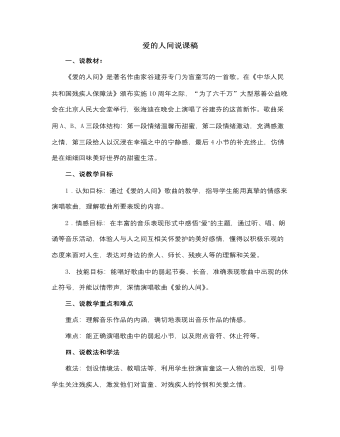
人音版小学音乐五年级下册爱的人间说课稿
2. 学唱歌词先听琴跟唱歌词,再分句解决难点:重难点:(1). 第一段中弱拍休止符的地方。(2). 附点四分音符:第一第二句的“总”, 第三句的“为”和第四句的“飘”;附点八分音符:第一第二句的“暖”,第三第四句的“总”。(3). 区分第二遍歌词和第一遍歌词在节奏上的不同之处。(4). 结束句三拍休止符。3. 完整的有表情地演唱歌曲。(三)、拓展通过欣赏邰丽华等聋哑人跳的舞蹈《千手观音》,来教育学生学习残疾人刻苦努力、奋发图强的精神;通过欣赏爱心人士的捐助图片,教育学生要帮助和帮助关心我们身边的残疾人!(四)、总结老师总结:无数个小爱汇成一个大爱,让我们在爱的人间里生活的更加美好,最后让我们再次充满感情地唱出这首爱的赞歌,在歌声中结束本课!
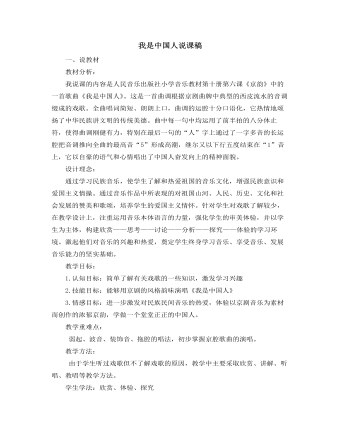
人音版小学音乐五年级下册我是中国人说课稿
5. 跟着范唱,完整地唱好全歌7. .以自豪的情感跟着伴奏带唱好京歌《我是中国人》。(音乐教育以审美为核心,主要作用于人的情感世界,使学生充分体验蕴涵于音乐音响形式中的美和丰富的情感,为音乐所表达的真善美理想境界所吸引、所陶醉,与之产生强烈的情感共鸣,使音乐艺术净化心灵、陶冶情操,以利于学生养成健康、高尚的审美情趣和积极乐观的生活态度。)8.鼓励学生单独演唱,师生共同评价,锻炼学生能够对自己和他人的演唱作简单评价。三、表演唱。因为戏歌和戏曲是分不开得,所以我向学生讲解戏曲中跑圆场这个动作,并辅导学生表演,用于歌曲的前奏。作为本科知识的延续,拓展学生的知识面,用戏歌作为学生走进戏曲的敲门砖。最后教师提出希望,鼓励学生从唱戏歌开始,慢慢地去了解戏曲,学习戏曲,敲开戏曲艺术的大门。
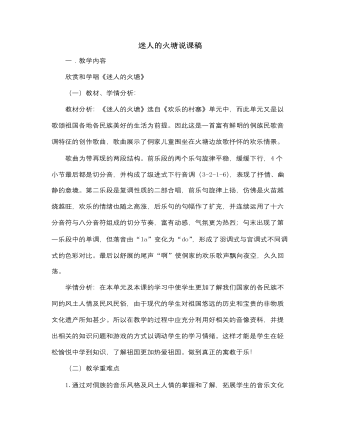
人音版小学音乐五年级下册迷人的火塘说课稿
最终使这节音乐课在这种快乐的氛围中结束,就像本课的歌曲迷人的火塘一样,那种迷人的情境永远留在我们的心中。这是课的结束部分,通过表演已学的民族歌舞与器乐演奏来巩固旧知,使主题突出,情感升华。(四)、小结:这节课我们来到了美丽的贵州,学习了一首具有鲜明的侗族民歌音调特征的创作歌曲,并了解了一些侗族的风土人情。通过今天的学习与感受,希望同学们能主动多了解些我国各民族的人文知识。为实现我们中华民族的伟大复兴而努力学习。五.教学反思本节课主要以一三四教学模式为教学方向,努力做到人人参与,小组合作,以学生为主,指导学生学习歌曲并从浅入深的让学生掌握歌曲的旋律。本节课环节过多,在时间分配上要注意,着重点要分清主次,有的环节也应该取舍得当。同时这使我明白了实践出真知的道理。我会继续努力的!
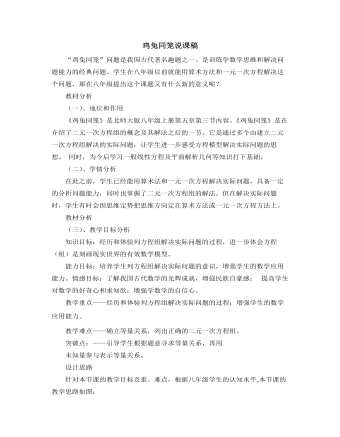
北师大版初中八年级数学上册鸡兔同笼说课稿
三、关于课本素材的处理课本素材:“鸡兔同笼”和“以绳测井”两个古代趣味问题。考虑到八年级学生独立思考和探索问题的能力都已达到一定的水平,特别增加了“自主探索,分层推进”这一环节,为每一位学生都提供了发展的空间。同时师生之间、学生之间共同研讨,形成教与学的和谐统一。凡能列二元一次方程组解决的问题,一般都可列一元一次方程来解,这就影响了用方程组去分析和解决问题,使学生形成思维定势。为此通过对“鸡兔同笼”多种求解方法的分析,使学生经历知识的发生过程,认识到列方程组的必要性和优越性,从而解决学生的思维定势的束缚。 以上是我对《鸡兔同笼》这一节课的一点思考,希望各位专家和老师指正,最后,我用布鲁克菲尔德的一句话来结束我的发言:让学生学会讨论、合作交流,讨论会使学生成为知识的共同创造者!
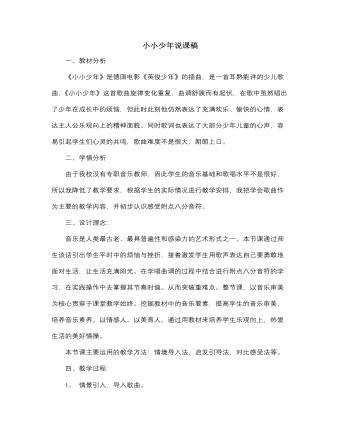
人音版小学音乐四年级下册小小少年说课稿
3、请同学朗读歌词。4、聆听歌曲《小小少年》。5、学习附点八分音符(1)看一看歌曲中用的最多的节奏是什么呢?用笔画出来。(2)听一听老师范唱与歌曲范唱的区别,哪种唱法好?(教师把附点音符改成八分音符来唱)(3)师从连音线的图解中讲解附点八分音符时值。得出结论:附点八分音符是在八分音符的基础上,延长把八音符的一半。(4)听辨练习。6、跟琴学唱曲谱,感受歌曲的弱起节奏。7、演唱歌曲分多种形式指导学生演唱歌曲。鼓励学生用明亮略带忧虑的情绪来演唱这首歌8、在《小小少年》中小主人公遇到了不小的烦恼,他被烦恼打倒从此消沉了么?他是怎样做的?我们同学的年龄跟他相仿,也许在某一天你的烦恼也会悄悄来临,希望你能象他一样用自己的智慧和爱心将困难克服掉,勇敢的迎接生活的挑战,做一个生活的强者!
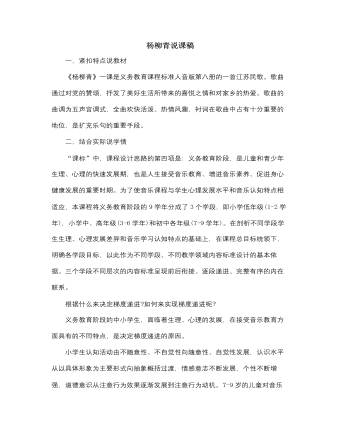
人音版小学音乐四年级上杨柳青说课稿
下面我们就一起来感受一下。3,学生自由选择强弱对比与老师接龙读衬词部分4,和老师一起加上拍腿拍手动作读一读衬词处拍腿,其余拍手5,师生唱谱,互动找到歌曲旋律的趣味性学习识谱要与演唱、演奏、创造、欣赏等活动密切结合,要以音乐为载体,在学生感性积累和认知的基础上进行。《标准》要求学生运用熟悉的歌曲或乐曲识读乐谱,也可以借助乐器演奏来学习。这即是说,学生学会读谱主要是通过音乐实践活动,而不是通过专门的读谱练习。通过以生动的音乐为载体,在学生感性积累和认知音乐的基础上进行识谱教学,要比单纯进行专门的“读谱训练”、“视唱练习”,其效果要好得多。在欣赏乐曲、教唱歌曲、演奏乐器和创造等活动中,结合着这些音乐实践活动进行识谱教学,就意味着在进行教唱歌曲等活动时“顺带着”学习识谱,而不是借教唱歌曲以达到学习识谱的目的。
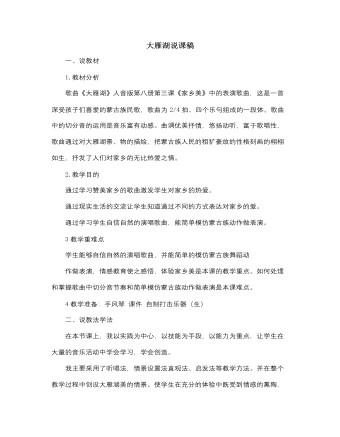
人音版小学音乐四年级上大雁湖说课稿
2、舞蹈渗透 爱的体验这个环节采用舞蹈表演化的设计,增强学生的学习兴趣。从歌曲中的节奏的练习后引出课题大雁湖,通过朗读歌词,熟悉歌曲内容,激发学生对大西北的热爱,又让学生按照歌曲的节奏读歌词,为学唱歌曲打下了基础,学生通过啦、呜、哩等声音来随琴模唱旋律。从教师表演蒙古舞蹈激发学生的学习兴趣,引出歌曲,让学生更加投入的进行歌曲学习当中来,从舞蹈表演到掌握歌曲,始终让学生在看看、听听、说说、唱唱、跳跳的轻松、愉快过程中学会歌曲。3、联系生活 爱的交流通过简单介绍自己家乡人、物、事等从而让学生获得了解家乡爱家乡共鸣。整堂课的爱家乡的教育使学生感悟体验对家乡的爱,通过爱家乡的呼唤让学生学会奉献,学会回报。此环节起到了画龙点睛升华的作用。